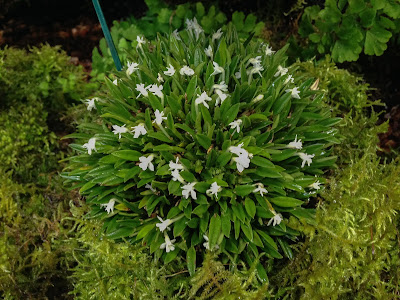Cadetia chionantha is endemic to New Guinea. It is found growing on tree trunks or branches covered with various mosses in mountain forests.
Cadetia chionantha also called as The Snow White Cadetia, Cadetia dischorensis, Cadetia furcillata, Dendrobium chionanthum, Dendrobium dischorense, Dendrobium furcillatum, is a species of the genus Cadetia. This species was described by Friedrich Richard Rudolf Schlechter in 1912.
IDENTIFY CADETIA CHIONANTHA
Cadetia chionantha is endemic to New Guinea. It is found growing on tree trunks or branches covered with various mosses in mountain forests at an altitude of 1300-2400 meters above sea level.
It is a mini-miniature sized, cool growing epiphyte with cylindrical, slightly tapering towards the apex pseudobulbs and carrying a single, narrowly linear, acute leaf. The leaves are 1-3 cm in length.
The Snow White Cadetia blooms in the fall on a 2.5 to 7.5 cm single flowered inflorescence. The flowers are 7 mm wide and are fragrant with the scent of vanilla.
CADETIA CHIONANTHA CARE AND CULTURE
Cultural information should only be used as a guide, and should be to be adapted to suit you. Your physical location; where you grow your plants, how much time you have to devote to their care, and many other factors, will need to be taken into account. Only then can you decide on the cultural methods that best suit you and your plants.
Light:
Cadetia chionantha needs a light level of 17000-20000 lux. The light should be filtered or dispersed, and the plants should not be exposed to direct sunlight in the afternoon hours. Strong air movement should be ensured all the time.
Temperature:
In nature, The Snow White Cadetia, being a mountain species, grows in climates with rather cool nights. The average temperature of the day is 24-26 ° C, night 13-15 ° C, giving a daily difference of 9-11 ° C
Humidity:
In its natural habitat there is less rain in winter, but still there are intense fogs and dews that provide water and humidity. In culture, the plant need the humidity of about 70-75%. Too dry air has a negative effect on the development of the plant: its growth is inhibited, and the leaves begin to turn yellow and dry out. The higher temperature, the higher the humidity should be, and the higher the humidity, the more often and longer it is necessary to ventilate the room where the plants are contained, otherwise the probability of rotting and various kinds of fungal diseases.
Substrate and growing media:
Cadetia chionantha is best mounted on a raft with live moss around the roots (which will cover them over time). This species loves humidity but hates stagnation of water, so cultivation in pots is impossible: it was either too wet or too dry. However, growing in a pot, you will have to carefully observe the condition of the plant for a few weeks to be able to notice any signs of stress as soon as possible and adjust the wetting. As a substrate, in this case, coarse fiber sphagnum is recommended.
Watering:
The Snow White Cadetia must be watered regularly, to always keep the roots moist. It absolutely does not like water stagnation, so pay attention to the drainage which must be perfect. In cultivation it is not necessary to reduce the wetting in winter, especially if the light is adequate.
Watering is directly dependent on the temperature of the content, the higher it is, the more often it needs to be watered. When watering, excess water should flow freely from the pot, since stagnation of water both inside the pot and in its pan can very quickly lead to rotting of the roots and the lower part of the plant.
Fertilizer:
It is recommended to use a 1/4 dose of orchid fertilizer every 3 weeks. You can use the balanced fertilizer throughout the year or from spring to mid-summer use high-nitrogen fertilizer, and then until the end of autumn high-phosphoric fertilizer to stimulate flowering.
Rest period:
Cadetia chionantha need less water in the winter, especially if they grow under the conditions of a dark, short day that occurs at moderate latitudes. They should dry somewhat between waterings, but they should not be dry for a longer period. Frequent morning fogging and rare, economical watering should allow the plant to go through a dry period of rest, while providing it with sufficient humidity. Fertilization should be reduced or eliminated until new growths appear and a more abundant spring watering begins.
















COMMENTS